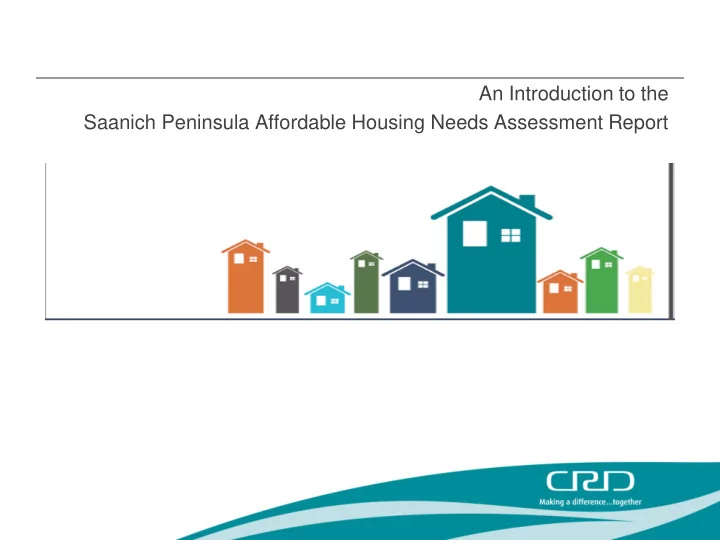

An Introduction to the Saanich Peninsula Affordable Housing Needs Assessment Report
Outline • Introduction to the Housing Data Book • Methodology • Statistics • Key Findings • Gap analysis • Questions
Introduction Why a Needs Assessment? 1. Development of the Saanich Peninsula Housing Roundtable Focus on Workforce Housing 2. Development of the Saanich Peninsula Affordable Housing Steering Committee Focus on those in core housing need CRD Regional Housing applied for funding to do a Needs Assessment Funding received through
Introduction Steering Committee Members Gary Holman, MLA Saanich North and Gulf Islands Councillor Celia Stock, North Saanich Councillor Barbara Fallot, Sidney Councillor Alicia Holman, Central Saanich Janis Gauthier, JG Consulting, Volunteer Christine Culham, Senior Manager, Regional Housing, Capital Regional District Rupert Downing, Community Social Planning Council of Greater Victoria
Methodology • Needs Assessment Framework • Literature Review • Quantitative Data • Qualitative data
Background: Shelter to Income Ratio • Why is the common understanding of affordable housing 30% of gross household income? • What is core housing need?
Population Demographics • North Saanich has the highest proportion (39%) of older workforce adults. • Central Saanich had the second highest proportion (35%) of older workforce adults. • Central Saanich has the highest proportions of children, youth, and younger workforce out of all the municipalities on the Saanich Peninsula. • Sidney has the highest proportion (36%) of seniors out of all the municipalities on the Saanich Peninsula and some of the lowest proportions of children and youth in the capital region.
Income distribution: Renter Households • 930 households with annual household incomes less than $30,000, representing approximately 33% of renter households
Income distribution: Owner Households
Housing Market Indicators • There have been 695 total housing starts between 2011 and 2015. • The number of housing starts has been increasing since 2012 on the Saanich Peninsula. • The average number of housing starts across the Saanich Peninsula from 2011 to 2015 was 139 per year.
Housing Market Indicators cont’d • A total of 95 (14%) purpose built rental starts were reported between 2011 and 2015. The highest number of rental housing starts (61) was reported in 2015. • Before that, the majority of the rental housing starts (41%) from 2011-2014 occurred in 2011 with housing starts decreasing in subsequent years to 21% in 2012, 18% in 2013 and 21% in 2014.
Renter Households • The average rent for Central Saanich was $957 and $937 for Sidney in 2015. Since 2011, average rents in Sidney have experienced some fluctuation with an overall rate of decline of - 0.2%. • Average rents in Central Saanich have increased by 4.2% since 2011 whereas average rents for the Victoria CMA have increased by 7.2% from 2011 to 2015. • In 2015, BC Housing reported that the organization administered 10,431 social housing units in the Capital Region. 6% of the region's social housing units were located on the Saanich Peninsula
Owner Households Municipality Average Price of single detached dwellings Central Saanich $706,780 North Saanich $835,618 Sidney $542,448
HOUSEHOLDS SPENDING >30% ON SHELTER COSTS 44% renter households 16,225 20% Households owner households
HOUSEHOLDS SPENDING >50% ON SHELTER COSTS 20% renter households 16,225 7% Households owner households
The Housing Continuum
Saanich Peninsula Gap Analysis Income distribution and housing supply inventory for the Saanich Peninsula
Key Findings • Additional data reveals that there are close to 4,000 families and individuals on the Saanich Peninsula who require better access to affordable housing in order to thrive, not just survive.
Key Findings THE THREE MAIN CONCLUSIONS OF THIS ANALYSIS ARE: • There is an urgent and immediate need for more on-reserve housing for First Nations. • There is an immediate need for transitional housing for women and children fleeing violence on the Peninsula. • There is a current and growing need for low-income rental housing for seniors and families on the Saanich Peninsula.
Thank you
Recommend
More recommend